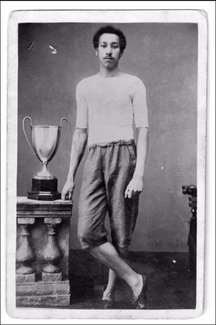“None of us are free, until we’re all free”

James Emmerson, whose ancestry includes both Romani and Jewish origins, discusses Diane Abbott’s recent reaffirmation of her controversial letter to the Guardian with Romani campaigner Ian Hancock and Black-Caribbean campaigner Shaun Campbell
In the aftermath of Labour MP Dianne Abbott’s second suspension due to her controversial comments about race: I ask, does either the politician or the British public fully understand Roma identity and their historical oppression as a people of colour?
The issue has re-emerged after comments the veteran MP made in a recent radio interview where she was defending a letter she wrote to the Guardian two years ago. In the letter she appeared to diminish the racism Jews, Irish and Travellers have been historically and presently subjected to - as being akin to having red hair.
She wrote: "It is true that many types of white people with points of difference, such as redheads, can experience this prejudice."
At the time, Abbott was suspended from the Labour Party, then reinstated after an apology where she claimed the letter had been sent by mistake. Two years later however she’s in hot water again after going back on her apology and therefore, seemingly admitting to either lying about the mistake, or acknowledging that her apology was insincere.
In a statement made on a BBC radio show "Reflections" hosted by James Naughtie, when asked whether she regretted her original statements from 2023 she said: "No, not at all. Clearly, there must be a difference between racism which is about colour and other types of racism, because you can see a Traveller or a Jewish person walking down the street, you don't know. But if you see a black person walking down the street, you see straight away that they're black. They are different types of racism.”
She added: "I just think that it's silly to try and claim that racism, which is about skin colour, is the same as other types of racism."
Later in a brief statement following her second suspension she doubled down, saying: “My comments in the interview with James Naughtie were factually correct, as any fair-minded person would accept."
Many figures in the media as well as the public at large appear to agree with her comments and at the very least offer a charitable level of understanding to her position. That said, others argue that her words lack nuance. What Abbott fails to recognise is that both Romani and Jewish people share a similar and unique history of persecution based not solely on their lifestyles or religious affiliation, but as non-white racial others.

When approached on the matter, Linguist and eminent Romani scholar Dr Ian Hancock OBE from the University of Texas said: “She's a damn fool. The problem is the use of the word gypsy in the UK, to cover non-Romani as well as Romani groups. And the genetic mixing of the various white and non-white Travellers confuses the picture further. Romani core culture in Britain has become so diluted, i.e. so lost, that being a "gypsy" justified one nasty journalist to say it was a job description and not an ethnicity. "Gypsy" as a self-ascription is also used by some Romani Travellers themselves, ignorant of its history and their own history.”
Abbott’s comments were directed towards Travellers and not Roma, but as highlighted by Dr Hancock, the term is often used loosely as a socio-cultural shorthand to include all Romani and non-Romani traveller groups. In the United Kingdom there does exist more recent Roma arrivals from continental Europe often fleeing persecution, discrimination and neglect again for reasons very much based on their appearance as a visibly non-white minority in their countries of origin.
Their cousins on the British Isles, Romanichals and Welsh Kale (Kale: Romani word meaning Black) are two branches of the broader Romani diaspora. This means they are descendants of those who arrived in the British Isles in the early 1500s and received the misnomer Egyptian, which then became Gypsy. This was a phenomenon that happened all over Europe where the Roma went, and it was very much based on colour. In the sixteenth century, subsequent discriminatory acts were put in place in England and Wales called the Egyptians Act, aimed to persecute and discriminate against this group.
This perception continued throughout the canon of English Literature and European popular culture, as well as official histories and even court proceedings. According to the website Proceedings of the Old Bailey, racial stereotypes of Romani people were occasionally employed, with physical descriptions including swarthy skin and the wearing of ostentatious, colourful clothes.
By the 20th century and the rise of eugenics, which then gave way to national socialism’s race biology, things got much worse. Nazi Race Scientist Dr Robert Ritter in 1936 became the head of the Center for Research on Racial Hygiene and Demographic Biology in the Third Reich’s Ministry of Health. He and his assistant anthropologist Eva Justin carried out field work where they would visit Roma and Sinti encampments, measure the skulls and make notes on hair colour, texture as well as eye and skin pigmentation of their subjects. Facial masks were also cast using live Roma-Sinti models all in order to provide a guide to recognising the phenotypic traits of Roma people.
During this time, Holocaust victim Johann Trollman, a German-Sinto professional boxer famously entered the ring in protest against the Reich’s oppressive racial laws, with his face and body powdered white with flour and his hair dyed blonde.

Jews were also subject to the same treatment, with grotesque nazi propaganda posters and cartoon images of pronounced and exaggerated dark semitic features in stark contrast to the blonde, blue eyed Aryan.
The concept of an Aryan race was of course proven to be mere fascistic pseudoscience and as a concept was shelved almost immediately following the Second World War. Today however both dark corners of the internet as well as political discourse seems to be ensconced in the term’s close cousin - “white people”. In the totality of human history this also is a relatively new concept and widely regarded as a social construct, coming about following the age of European expansionism. Historically, Roma, Jews and at times even the Irish, were excluded from such a club and suffered because of it. Therefore, the sudden inclusion of the same groups under the moniker of “whiteness”, is not only offensive, but brings about its own problems.
In the case of Diane Abbott, it begs the question, what were her motives if not to declare that Jews, Gypsies and the Irish don’t count in her sense of a social hierarchy of oppressed groups based on perceived melanation. This reflects and simultaneously turns on its head, old images of signs outside boarding houses of “no blacks, no dogs, no Irish." The difference now being, its “no Jews, no Gypsies and again no Irish”, allowed into the exclusive club of oppressed minorities.
I would argue that this is a way of thinking that goes beyond one politician and her recurring faux pas. In the fallout at the end of last week, James O’Brien’s LBC phone-in featured a caller of Pakistani descent who hailed Abbott as “the Malcom X of our time”. The man went on to say that all people of colour fully understand her position and that Travellers, Jews and Irish do have more in common with redheads than they do with him.
Though O’Brien countered this argument, he still failed to point out that factually the caller couldn't be further from the truth. If only the man had been made aware of who Romani people are, then he would have realised his adjacency to them as a fellow Brit of South Asian origin.
Historical Romani persecution includes the longest running chattel slavery in the world carried out in what is now modern day Romania and Moldavia, as well as being transported and enslaved by the Spanish, Portuguese and British in the Americas.
The presence of Romani people in the Caribbean during the Transatlantic Slave trade is a fact that Abbott not only fails to recognise, but ironically back in 2023 used as a way to compound her message in the letter, where she wrote: “there were no white-seeming people manacled on the slave ships.”
Well perhaps not, if you perceive the Romanies as people of colour, but she clearly doesn’t.
As highlighted in the work of the various Romani scholars, including the previously mentioned Dr Hancock, there is also evidence of freed black slaves in the Caribbean and American colonies as owning Romani slaves, this is of course a sticky wicket all-round, but nevertheless it happened and thus highlights the complexities and nuances of such a history.
As a musician and a writer, with both Romani and Jewish origins, I have openly championed civil rights causes and collaborated with the work of the Arthur Wharton Foundation. The latter is an organisation set up to promote racial equality and give recognition to the Black-British sporting pioneer Arthur Wharton. Only six months ago was I performing on stage a song I wrote about Arthur, the world’s first black professional footballer, to a theatre full of people of various ethnic backgrounds including African Caribbean and African descent.

Speaking to the head and founder of the foundation, Shaun Campbell, who himself is of Black-Caribbean origin, he said: “First of all, I have to question the reasoning for her (Abbott) making these comments, I’m not sure what she’s trying to achieve. But it is a tricky one, I do agree with her to an extent, the issue of visibility is an important one. In the context of football for example, you have Eric Cantona, Andrea Pirlo and many others who are of Romani descent, but they spent their careers with their heritage relatively hidden, whereas that doesn’t happen to black players. I think that’s more or less Diane’s thinking and I do agree with it.”
“That said, I’m also aware that there are Roma people and Jewish people in certain parts of the world, in certain contexts where though perhaps less evident, they very much do stand out due to stereotypes based on their physical appearance.”
“I’m very much in the position where we can’t be too one track minded. Diane has been through so much as a politician, as the first black female MP and been on the receiving end of torrents of abuse throughout her career because of it. These experiences inevitably bring someone to become heavily more invested in their own struggle and then become less aware of others.”
“We have to acknowledge our uniqueness of course, but I’m a believer in being open to conversations and hearing from people from other groups in a way to understand what issues they’re dealing with, things that we can learn from and also empathise with, because we’ve been through it ourselves.”
Sharing the ethos of Campbell’s message, I am reminded of a phrase used by Martin Luther King during the civil rights movement, but was in actual fact first attributed to American Sephardic Jewish writer Emma Lazarus in 1883, as a call to all Jews in the midst of the pogroms against the Ashkenazi Jewish population of Eastern Europe, “None of us are free, until we’re all free.”
By James Emmerson
(Top photograph by Policy Exchange - Flickr: Diane Abbott MP delivering her keynote speech 'Children and public health: putting families at the heart of policy', CC BY 2.0, https://commons.wikimedia.org/w/index.php?curid=50350674)